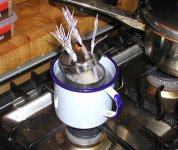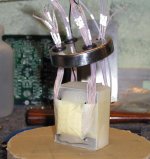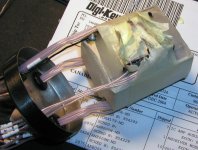Peter Daniel said:I noticed that gold spikes are a big no no with Europeans. Here, in Americas, nobody's really complaining 😉
Those are quite nice, definitely not $1 variety, and they match RCA jacks. I was already thinking about powder coating them in some nice color (as making the new ones would be too expensive, considering the original cost of those).
Anyway this tiny preamp looks like somebody did design it with care for every screw ... but then these standard-business-class-spikes ... I know they cost more than $1 but they just look like mass-production. Unlike the rest of this piece of art.
You should use silver-coated jacks anyway 😉 Maybe Eichmann or WTB Nextgen.
Funny, in British hifi magazins they feel Germans do like those gold things ... maybe this is a result of Clearaudio and JRTransrotor vinyl altars ... maybe I am not german enough.
Cheers
Christian.
Some of you might be interested what's inside those cans. Well, today I had a chance to find out. After putting preamp together and performing first test, I was quite surprised that one channel didn't perform properly.
Apparently the '+' wire was disconnected inside the can. It's hard to say how it happened, as the transformers are checked after manufacturing, but I also don't recall pulling on any wires too hard.
Since they are potted in wax, this is the first step to do 😉
Apparently the '+' wire was disconnected inside the can. It's hard to say how it happened, as the transformers are checked after manufacturing, but I also don't recall pulling on any wires too hard.
Since they are potted in wax, this is the first step to do 😉
Attachments
Hey Peter,
Wondered what the 102's looked like on the inside.
In a previous post I mentioned a difference in resistance between the screen/core and the cans for my pair of 102's. While you had those apart, did you notice in what manner the core or screen contacts the cans. Looks like everything is tape covered and insulated.
Thanks,
scottw
Wondered what the 102's looked like on the inside.
In a previous post I mentioned a difference in resistance between the screen/core and the cans for my pair of 102's. While you had those apart, did you notice in what manner the core or screen contacts the cans. Looks like everything is tape covered and insulated.
Thanks,
scottw
As you see, black wire is soldered to transformer's core. There is another wire without label, marked as internal screen, but in all excitement I forgot to check where it's connected. It doesn't seem like anything is attached to the cans, but somehow they show connection with the screen.
Peter,
Very cool stuff. The preamp is beautiful. Absolutely great industrial design.
May I be perfectly frank, according to my opinion of course, about a few things?
I think the lettering on the jack/switch plate may be a little too big. I'd think the lines of the font should be a little thicker, but the letters should be just a bit smaller. Also, perhaps a different font may work better, as well. I would think that the font should either mirror the hard lines of the milled aluminum or mimic the curvature of the transformers' curves. Right now it's something in between. I'd actually prefer it if the font played off of the curvature of the transformers. That would intergrate the font with the amp, but also give some contrast to the hard lines of the aluminum.
Also, I think the script-like flourish in the logo is at odds with the precise, scientific instrument-like quality of the metalwork. Just seems out of place to me. Your amps seem very solid, well-crafted, and modern to me. The flourish in script reminds me of something more baroque. Makes me think of woodwork and fine fabrics, and such.
I like the milled aluminum very much, but the over-all effect is a little bit monochrome. Just in terms of visual interest, I find the acrylic preamp more interesting. There's a contrast of colors and textures that's, well, very interesting to look at.
I don't know how you'd deal with that, but I think the blue color of the foam between TXs and the aluminum adds some interest to it. Perhaps just a two color screening on the logo would be enough to add this visual interest - maybe one of these colors could mimic the color of the foam.
Otherwise, I think the amp is very, very cool and it would most certainly take pride-of-place in my system if I had one in my house. Great design.
Please don't take this as any sort of unwonted criticism. It's just my opinion about a few points, that's all. Yeah, I was in art school for too long.
Anyhow, great work, and thanks for sharing the pictures to the TX insides. They're so mysterious when they're inside the cans.
Best,
KT
Very cool stuff. The preamp is beautiful. Absolutely great industrial design.
May I be perfectly frank, according to my opinion of course, about a few things?
I think the lettering on the jack/switch plate may be a little too big. I'd think the lines of the font should be a little thicker, but the letters should be just a bit smaller. Also, perhaps a different font may work better, as well. I would think that the font should either mirror the hard lines of the milled aluminum or mimic the curvature of the transformers' curves. Right now it's something in between. I'd actually prefer it if the font played off of the curvature of the transformers. That would intergrate the font with the amp, but also give some contrast to the hard lines of the aluminum.
Also, I think the script-like flourish in the logo is at odds with the precise, scientific instrument-like quality of the metalwork. Just seems out of place to me. Your amps seem very solid, well-crafted, and modern to me. The flourish in script reminds me of something more baroque. Makes me think of woodwork and fine fabrics, and such.
I like the milled aluminum very much, but the over-all effect is a little bit monochrome. Just in terms of visual interest, I find the acrylic preamp more interesting. There's a contrast of colors and textures that's, well, very interesting to look at.
I don't know how you'd deal with that, but I think the blue color of the foam between TXs and the aluminum adds some interest to it. Perhaps just a two color screening on the logo would be enough to add this visual interest - maybe one of these colors could mimic the color of the foam.
Otherwise, I think the amp is very, very cool and it would most certainly take pride-of-place in my system if I had one in my house. Great design.
Please don't take this as any sort of unwonted criticism. It's just my opinion about a few points, that's all. Yeah, I was in art school for too long.
Anyhow, great work, and thanks for sharing the pictures to the TX insides. They're so mysterious when they're inside the cans.
Best,
KT
Peter,
Do the Bent Audio TX102 mk3s with OCC copper windings and cast copper output wires sound different than the group order offering?
Thanks,
KT
Do the Bent Audio TX102 mk3s with OCC copper windings and cast copper output wires sound different than the group order offering?
Thanks,
KT
I never had a chance to compare transformers with different wire side by side. Twice, I was using them with the regular wire (silver plated) and it was definitely much easier to work with, as Bent Audio wire is enameled.
I didn't noticed any major dofferences in sound, but I'm also not sure which version of transformers I had.
As to your comments regarding preamp, they are very appreciated. I had practically no control over prints artwork, as I only provided sketch of what I wanted and somebody else took care of fonts and silkscreening.
It seems to me like front panel needs more detailing, and deep engraving with wider lines logo (which of course could be different, as this one is pasted from AMP-1) would fit there nicely, so maybe this will be tried in next production run.
I didn't noticed any major dofferences in sound, but I'm also not sure which version of transformers I had.
As to your comments regarding preamp, they are very appreciated. I had practically no control over prints artwork, as I only provided sketch of what I wanted and somebody else took care of fonts and silkscreening.
It seems to me like front panel needs more detailing, and deep engraving with wider lines logo (which of course could be different, as this one is pasted from AMP-1) would fit there nicely, so maybe this will be tried in next production run.
ttt to see if anyone has any more info to report about their preamps.
I have been too busy to start mine yet but I am hoping to find some time in the next couple of weeks.
Still looking for a nice enclosure !
I have been too busy to start mine yet but I am hoping to find some time in the next couple of weeks.
Still looking for a nice enclosure !
I've been running mine for about a month now and they have definitely improved over that time. Straight out of the box they were great, but since then they have developed a slightly deeper base and more holographic imaging. The bass is simply stunning; deep and I never realised just how tuneful bass can be , before I built these.
i built mine into an old naim chassis that I bought as a scrap preamp. Cleaned up the case and made a different back plate. Works well while I decide what to do for a phono pre.
Kev
i built mine into an old naim chassis that I bought as a scrap preamp. Cleaned up the case and made a different back plate. Works well while I decide what to do for a phono pre.
Kev
Having seen Peter Daniels pictures I couldn't get near those on build quality or beauty. If you're interested I'll post an internal pic, outside it looks like a Naim 32.5 pre.
Kev
Kev
Hello,
I soldered some 13K resistors parallel to TX input yesterday, in order to get 10k input impedance to get my CDP filter working properly. Sound did improve; anyhow it seemed to be much louder then...
Cheers
Christian.
I soldered some 13K resistors parallel to TX input yesterday, in order to get 10k input impedance to get my CDP filter working properly. Sound did improve; anyhow it seemed to be much louder then...

Cheers
Christian.
input switch advice
A few weeks ago when I order my two TX-102, I was almost clear that I need an input switch break-before-make (avoiding the input sources will be short-circuiting each other) and with 4 poles in order to switch inputs and ground separately.
While I'm waiting for my TX's I'm reading various forums and now I became a lot confused and concerned about thumps.
Some people says that if you use b-b-m switches you will get switching thumps.
Even In this thread someone suggested that thumps happens when you switch source ground.
So please, a need your expertise advise about what kind of switch is better, b-b-m or m-b-b? switched grounds or not?
A few weeks ago when I order my two TX-102, I was almost clear that I need an input switch break-before-make (avoiding the input sources will be short-circuiting each other) and with 4 poles in order to switch inputs and ground separately.
While I'm waiting for my TX's I'm reading various forums and now I became a lot confused and concerned about thumps.
Some people says that if you use b-b-m switches you will get switching thumps.
Even In this thread someone suggested that thumps happens when you switch source ground.
So please, a need your expertise advise about what kind of switch is better, b-b-m or m-b-b? switched grounds or not?
It is my experience that you will get thumps when switching both grounds and signals with bbm switches. I think it's better to use mbb switches, or don't switch grounds. Depending on your sources, switch and the rest of the setup, the thumps may be negligable or quite obvious.
Since some of you may put those preamps together, I would be curious which gain setting is preferrable by majority? Each time I check it (with other listeners), it seems that +6dB is preferrable.
That's really going to depend on gain structure and source and load impedances, isn't it?Peter Daniel said:Since some of you may put those preamps together, I would be curious which gain setting is preferrable by majority? Each time I check it (with other listeners), it seems that +6dB is preferrable.
- Home
- Design & Build
- Parts
- how to build a pre using S&B TX-102 transformers


